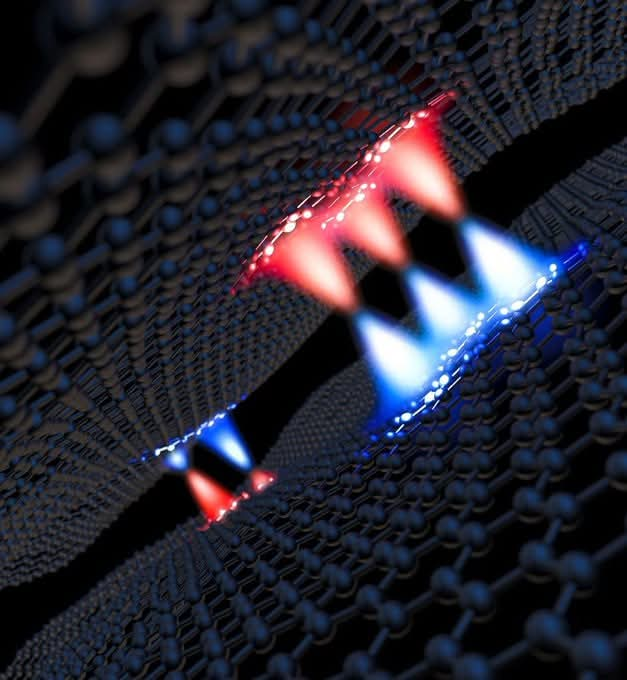A New Kind of Particle Love Story in Quantum Land
Physicists reveal a previously unobserved type of subatomic phenomenon that could make future quantum computers more reliable. 🖥️ The NSF-supported findings provide new understanding of the quantum properties of materials.
image credit: Brown University
https://bit.ly/43PvWyI
https://www.nature.com/articles/s41586-024-08274-3
A New Kind of Particle Love Story in Quantum Land
In the strange and tiny world of quantum physics, particles like electrons and their "missing partners" called holes can form bonded pairs known as excitons—sort of like a dance between positive and negative charges. Traditionally, these pairs are made from particles carrying whole-number charges, like +1 or -1. But what happens when you shrink things down further, into exotic quantum states where charges are chopped into fractions?
This is the domain of the fractional quantum Hall effect, a bizarre phase of matter that emerges under ultra-cold temperatures and strong magnetic fields. Here, particles don’t always play by the usual rules. Theoretically, physicists have long predicted that in such environments, fractional excitons—pairs made from particles carrying fractional charges—should exist. But until now, no one had actually seen signs of them.
That changes with this study.
Researchers have found experimental evidence of these fractional excitons in specially layered quantum systems. By closely examining how these exotic particles behave and influence their surroundings, the team uncovered two entirely new phases of quantum matter. One of them resembles a well-known phenomenon called an exciton condensate, but with a twist: it’s built from fractional charges. The other is even more surprising—it suggests a type of exciton that doesn't follow the usual quantum rules and might not behave like ordinary bosons at all.
In essence, this discovery opens a new chapter in our understanding of quantum matter, showing that even the “love stories” between particles can take surprising turns when the rules of the game are rewritten by quantum physics.
#physics #quantumphysics #excitons

물리학자들은 이전에는 관찰되지 않았던 아원자 현상을 밝혀냈는데, 이는 미래의 양자 컴퓨터의 신뢰성을 높일 수 있을 것입니다. 🖥️ NSF의 지원을 받은 이 연구 결과는 물질의 양자적 특성에 대한 새로운 이해를 제공합니다.
이미지 출처: 브라운 대학교
https://bit.ly/43PvWyI
https://www.nature.com/articles/s41586-024-08274-3
양자 세계의 새로운 입자 러브스토리
양자 물리학의 기묘하고 작은 세계에서 전자와 그 "잃어버린 파트너"인 정공은 엑시톤(exciton)이라는 결합 쌍을 형성할 수 있습니다. 마치 양전하와 음전하가 춤을 추는 것과 같습니다. 전통적으로 이러한 결합 쌍은 +1 또는 -1과 같은 정수 전하를 갖는 입자로 구성됩니다. 하지만 전하가 분수로 잘려 나간 특이한 양자 상태로 더 작아지면 어떻게 될까요?
이것은 초저온과 강한 자기장 하에서 나타나는 기이한 물질 상태인 부분 양자 홀 효과의 영역입니다. 여기서 입자들은 항상 일반적인 법칙을 따르지는 않습니다. 이론적으로 물리학자들은 이러한 환경에서 부분 전하를 갖는 입자들로 구성된 쌍인 부분 엑시톤이 존재할 것이라고 오랫동안 예측해 왔습니다. 하지만 지금까지 아무도 실제로 그 흔적을 본 적이 없습니다.
이번 연구로 상황이 달라집니다.
연구진은 특수 층으로 구성된 양자 시스템에서 이러한 부분 엑시톤의 실험적 증거를 발견했습니다. 이러한 특이한 입자들이 어떻게 행동하고 주변 환경에 영향을 미치는지 면밀히 조사함으로써 연구팀은 양자 물질의 완전히 새로운 두 가지 상태를 발견했습니다. 그중 하나는 엑시톤 응축이라는 잘 알려진 현상과 유사하지만, 다른 점이 있습니다. 부분 전하로 구성되어 있다는 것입니다. 다른 하나는 훨씬 더 놀라운데, 일반적인 양자 법칙을 따르지 않고 일반적인 보손처럼 행동하지 않을 수도 있는 유형의 엑시톤을 시사합니다.
본질적으로, 이 발견은 양자 물질에 대한 우리의 이해에 새로운 장을 열었으며, 양자 물리학에 의해 게임의 규칙이 새롭게 쓰여질 때 입자들 간의 "러브 스토리"조차도 놀라운 전환점을 맞이할 수 있음을 보여줍니다.
#물리학 #양자물리학 #엑시톤